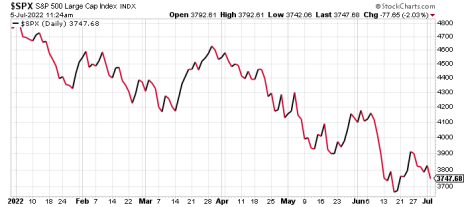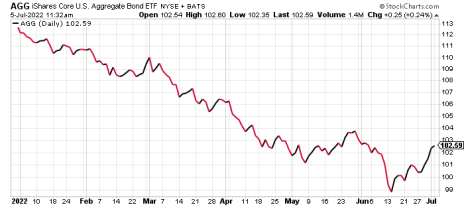Benjamin Graham, known as the father of value investing, wrote about the difference between investing and speculation. He described the stock market as a short-term voting machine and a long-term weighing machine. In other words, the research and investment process wins out over the long haul.
However, as we know, there are also eras when those concepts are drowned out by the loud noise of investors experiencing the thrill of making money as if there were no risk attached.
When I was a financial advisor, I observed that the era of unbridled market enthusiasm ended with the 2007-2009 market meltdown. Some prospects who visited my office for the first time were completely unaware that markets had completely recovered - and then some – by 2013. Others knew markets had rallied, but were never able to stop worrying that another crash could come at any moment, wiping out their nest egg.
[text_ad]
At the moment, bubbles are bursting everywhere, and inflation is spiking. Recession is on the lips of many forecasters, and the Fed is about to cause a massive shift by changing just one letter in their policy approach: QE (Quantitative Easing) becomes QT (Quantitative Tightening).
As a result, most investors (and the financial media) are fretting, rather than trying to identify opportunity.
But there’s another way to view this moment in history: This year may turn out to be one of the best times to grab the opportunities available. But to do that, you’ll have to shift your mindset from traditional investing to tactical trading.
You Know It’s a Bear Market When…
1. The bull market has run amok: One of the classic characteristics of late-stage bull markets is the narrow breadth when progressively fewer stocks participate in the market’s advances. Another is excessive risk-taking by investors who have no business speculating on stocks.
What was once a fundamentally driven, even-handed upward move off historic market lows turns into an increasingly fragile environment, where the major market indexes mask underlying deterioration. This began to occur late last year, as the S&P 500 failed to launch a sustained rally, eventually rolling over in January.
2. Leverage in all corners of the economy: Consumers, governments and businesses typically take on more debt than they should. Maybe that feels like a bit of moralizing, but debt is generally OK, until conditions change and that debt must be repaid. If borrowers can’t service their debt, then defaults on mortgages, credit cards and on the corporate level, high-yield bonds, characterize this stage.
3. A Scapegoat starts the eventual snowball downward: It could be China’s slowing growth, some other international event – such as the Russian invasion of Ukraine – or worries about central bank activity. But these are just rationalizations for what is really the inherent cyclicality of stock prices. They don’t go up or down forever.
4. More Denial
Wall Street pundits get more devout than ever about the extension of the great bull market. But remember, their livelihood depends on bull markets! They’re happy to go on CNBC or Bloomberg and tell you to “buy the dip” or “stay the course.” (The latter is a favorite saying of financial advisors, whose income also depends upon assets under management.)
5. Finally, price rules
Stock market technical levels break, resulting in lower lows and lower highs, replacing the previous pattern of higher highs and higher lows. And the bear market, which has been lying in wait for months, finally arrives.
The good news is that bear markets can be navigated and a bull market follows every bear market. That particular pattern has never failed.
Bear Market Reality
- Technical analysis matters more than ever. Many fundamental investors say that the market is fairly valued. But I’ve been charting stocks for more than two decades, and it appears to me that this market is as threatening to wealth as in 2000 and 2007. (It so happens that the fundamentals also support the case for a bear market, although my buy and sell decisions are dictated by the charts.)
- That Ben Graham quote is extremely relevant today: Value investor Graham (also Warren Buffett’s mentor) said that in the short run the stock market is a voting machine, and in the long run, it’s a weighing machine. In other words, great businesses will be thrown out with the weaker ones in a bear market. That’s why I am making a list now of what I would like to own at prices 20-50% below where they are at the moment. We have even purchased some of them in the portfolios of our Cabot ETF Strategist, which subscribers can view here.
- There will be a point where no one cares what your stock’s valuation is: Eventually investors using margin and other forms of leverage are forced to liquidate holdings. Redemptions from those “easy and cheap” S&P 500 Index funds will just cause a nasty ripple effect for many prominent companies.
- The economy is not the stock market: The stock market looks to the economy for clues about the future. Once the bear cycle starts rolling, the stock market has a way of dragging the economy down with it. Recession in 2022 or 2023? That’s a real possibility, and one that looks increasingly likely.
- Bonds are a portfolio Band-Aid, that’s all: High-quality bonds like treasuries and some munis and corporates might fare well in a “flight to quality” that results from a bear market in equities. But as far as the long-term return of these investments goes, you are somewhere between a very low positive return and a negative return.
For example, the iShares Core US Aggregate Bond ETF (AGG) is down 10.1% year-to-date. That’s hardly the ballast you’re looking for when equity markets are also in a steep decline.
How to Navigate the Bear Market
Recognize that markets have changed, probably for the foreseeable future. In other words, don’t expect a rapid return to a roaring bull. That includes a market driven more by momentum and price patterns than by “intrinsic value,” as Graham called it.
- The best defense is…a great defense! But many investors don’t have one: Running to cash or short-term bonds is one way to try to defend against the bear, but all you are doing is playing a guessing game with your money. Every bear market is different. Some rally back fast; your attempts at timing could backfire. One idea is to use portfolio hedges (inverse ETFs or perhaps put options) to prevent major losses, instead of holding a huge cash position, which many programs advise.
- Income investors are approaching a “dream” scenario: Bear markets allow you to buy companies you wish you had bought the last time around. But now you can buy at yields you can lock into for several years and be very happy with. After all, when stock prices go down, yields go up.
- Do the equity manager “two-step.” Have patience now, be contrarian later. Bear markets allow us to reset our portfolios. The idea is that we identify which current holdings to keep and which stocks we want to buy when everything is marked down significantly.
- Investing goals are best thought of over periods of three to five years: Some of the biggest mistakes we see in investing have to do with inconsistent time horizons. It is one of the first things a new client discusses with an investment advisor, yet it seems all of that forethought is forgotten once the market pulls back a bit. Rather than get caught up with the recent decline in your portfolio, or become one of those you just lost or be one of those “buy-and-hold forever” types, the healthiest balance is to focus on what you want to accomplish over the next three to five years, regardless of market conditions.
Want more ideas on how to navigate the bear market? Or what to buy once stocks finally bottom and start gaining steam again? Click here to subscribe to my Cabot ETF Strategist, where I not only recommend a full portfolio of ETFs and index funds but also help you allocate and diversify properly.
[author_ad]



